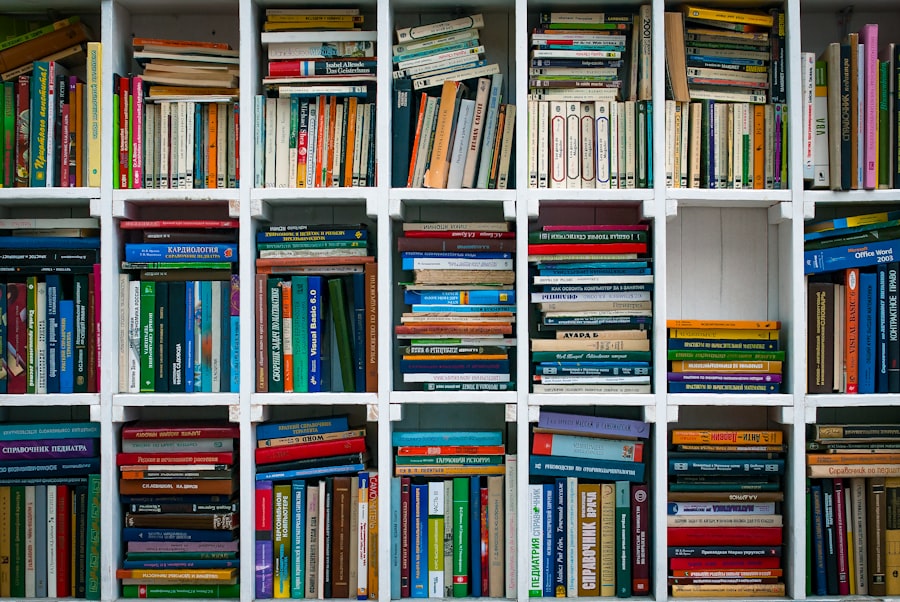Built-in bookshelves with cabinets offer a multitude of advantages that extend beyond mere aesthetics. One of the most significant benefits is their ability to optimize space in a room. Unlike freestanding bookshelves, which can take up valuable floor space, built-ins are designed to fit snugly against walls, making them ideal for smaller rooms or areas where maximizing square footage is essential.
This integration into the architecture of a home not only creates a seamless look but also allows for more efficient use of space, providing ample storage without cluttering the environment. Additionally, built-in bookshelves with cabinets can enhance the overall value of a home. Potential buyers often view these features as desirable upgrades, as they suggest a level of craftsmanship and attention to detail that can elevate the appeal of a property.
The combination of open shelving for display and closed cabinets for storage creates a balanced design that caters to both functionality and style. This duality allows homeowners to showcase their favorite books, decorative items, or personal collections while keeping less visually appealing items out of sight, contributing to a more organized and polished living space.
Key Takeaways
- Built-in bookshelves with cabinets offer enhanced storage and aesthetic appeal.
- Customization allows for tailored designs to fit specific spaces and needs.
- They help maximize space efficiently in various rooms of the home.
- Selecting appropriate materials and design tips ensures durability and style.
- Regular maintenance is essential, and cost varies based on materials and complexity.
Customization Options for Built-in Bookshelves with Cabinets
One of the most compelling aspects of built-in bookshelves with cabinets is the extensive range of customization options available. Homeowners can tailor these installations to fit their specific needs and preferences, ensuring that the final product aligns perfectly with their vision. Customization can include variations in height, width, and depth, allowing for a design that complements the unique dimensions of any room.
For instance, a homeowner with high ceilings might opt for taller shelves that draw the eye upward, creating an illusion of even more space. Moreover, customization extends beyond mere dimensions; it encompasses style and finish as well. Homeowners can choose from an array of materials, colors, and textures to create a cohesive look that harmonizes with existing decor.
Whether one prefers the warmth of natural wood, the sleekness of painted finishes, or even mixed materials for a more eclectic vibe, the possibilities are virtually limitless. Additionally, features such as adjustable shelving, integrated lighting, and specialized compartments for electronics or media can be incorporated into the design, further enhancing functionality and user experience.
Maximizing Space with Built-in Bookshelves and Cabinets

Maximizing space is a primary consideration when designing built-in bookshelves with cabinets. These installations can be strategically placed in various areas of a home to serve multiple purposes while maintaining an organized appearance. For example, in a living room, built-ins can be designed to house not only books but also multimedia equipment, games, and decorative items.
By incorporating cabinets at the base, homeowners can conceal unsightly cords and devices, creating a clean and streamlined look. In smaller homes or apartments, built-in bookshelves can serve as room dividers, effectively delineating spaces without the need for additional walls. This approach allows for an open-concept feel while still providing functional storage solutions.
In a studio apartment, for instance, a built-in bookshelf can separate the sleeping area from the living space while offering ample storage for books and personal items. This versatility makes built-ins an excellent choice for maximizing both storage and living space in any home.
Incorporating Built-in Bookshelves with Cabinets into Different Rooms
| Room | Common Uses | Average Dimensions (WxH) | Material Options | Storage Capacity (Books + Items) | Estimated Installation Time | Design Considerations |
|---|---|---|---|---|---|---|
| Living Room | Display books, decor, media equipment | 72″ x 84″ | Wood, MDF, Plywood | 150-200 books + decor items | 2-4 days | Blend with existing furniture, cable management |
| Home Office | Organize books, files, office supplies | 60″ x 80″ | Wood, Laminate, Metal accents | 120-180 books + files | 2-3 days | Ergonomics, easy access to frequently used items |
| Bedroom | Books, personal items, decorative storage | 48″ x 72″ | Wood, Painted MDF | 80-120 books + personal items | 1-3 days | Space-saving, soft-close cabinets for quiet |
| Dining Room | Display china, books, barware | 60″ x 78″ | Wood, Glass-front cabinets | 50-100 books + dishware | 2-4 days | Moisture resistance, elegant finishes |
| Hallway | Storage for books, keys, small decor | 36″ x 72″ | Wood, MDF | 40-80 books + small items | 1-2 days | Maximize narrow space, slim profile |
The versatility of built-in bookshelves with cabinets allows them to be seamlessly integrated into various rooms throughout a home. In a home office, for example, these installations can provide essential storage for books, files, and office supplies while also serving as a backdrop for video calls or meetings. A well-designed built-in can create an inspiring workspace that encourages productivity while keeping clutter at bay.
In family rooms or dens, built-ins can be designed to accommodate entertainment systems alongside traditional book storage. By incorporating cabinets for media equipment and games, families can create a centralized hub for leisure activities. In bedrooms, built-in bookshelves can serve as stylish nightstands or reading nooks, providing easy access to favorite novels while maintaining an organized appearance.
The adaptability of built-ins makes them suitable for any room in the house, enhancing both functionality and design.
Design Tips for Built-in Bookshelves with Cabinets
When designing built-in bookshelves with cabinets, several key tips can help ensure a successful outcome. First and foremost is the importance of scale and proportion. The size of the built-ins should be proportionate to the room they occupy; oversized shelves in a small space can feel overwhelming, while undersized units in larger rooms may appear lost.
It’s crucial to consider the overall layout and flow of the room when determining dimensions. Another essential design tip is to incorporate visual interest through varying shelf heights and depths. This approach not only adds character but also allows for creative display options.
Mixing open shelves with closed cabinets creates a dynamic look that balances functionality with aesthetics. Additionally, integrating lighting into the design—such as LED strips or spotlights—can highlight specific items on display while adding warmth to the overall ambiance of the room.
Choosing the Right Materials for Built-in Bookshelves with Cabinets

Selecting appropriate materials is critical when designing built-in bookshelves with cabinets. The choice of material not only affects durability but also influences the overall aesthetic of the installation. Solid wood is often favored for its timeless appeal and strength; hardwoods like oak or maple provide longevity and can be stained or painted to match any decor style.
However, engineered wood products such as plywood or MDF (medium-density fiberboard) are also popular due to their cost-effectiveness and versatility in design. In addition to wood options, homeowners may consider incorporating glass elements into their built-ins. Glass-front cabinets can showcase valuable collections while protecting them from dust and damage.
Furthermore, metal accents—such as brackets or handles—can add a modern touch to traditional wood designs. Ultimately, the choice of materials should reflect both personal style and practical considerations such as maintenance and wear over time.
Maintenance and Care for Built-in Bookshelves with Cabinets
Maintaining built-in bookshelves with cabinets is essential to ensure their longevity and appearance over time. Regular cleaning is crucial; dust accumulation can dull finishes and detract from the overall look of the installation. A soft microfiber cloth is ideal for wiping down surfaces without scratching them.
For wooden shelves, periodic polishing with appropriate wood care products can help maintain luster and protect against wear. In addition to routine cleaning, it’s important to monitor humidity levels in the home, especially if wooden materials are used. Excessive moisture can lead to warping or mold growth, while overly dry conditions may cause cracking or splitting in wood components.
Using dehumidifiers or humidifiers as needed can help maintain an optimal environment for both books and furniture alike.
Cost Considerations for Built-in Bookshelves with Cabinets
When contemplating built-in bookshelves with cabinets, cost considerations play a significant role in decision-making. The price range for these installations can vary widely based on factors such as materials used, complexity of design, and labor costs associated with installation. Custom-built options tend to be more expensive than pre-fabricated units due to the tailored nature of the work involved.
Homeowners should also factor in potential long-term savings associated with built-ins versus freestanding furniture. While the initial investment may be higher for custom installations, built-ins often provide superior durability and functionality that can enhance property value over time. Additionally, by maximizing storage space and reducing clutter, built-ins may contribute to lower costs associated with purchasing additional furniture or storage solutions in the future.



